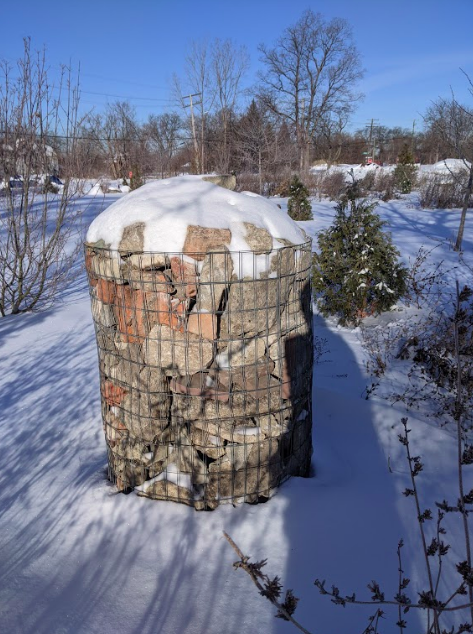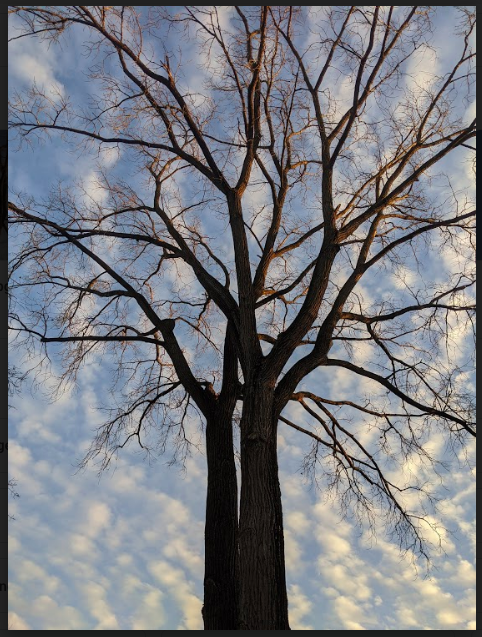What are these cylindrical forms of rubble that are rising from the arboretum? Stupas?
As defined by the Encyclopedia Britannica a Stupa is a Buddhist commemorative monument usually housing sacred relics associated with the Buddha or other saintly persons. This makes sense in the way that these relics are the skeletons of the houses that have sacrificed themselves to the project of returning the landscape to trees and plants, rewilding, native habitat restoration. I like to think of this work as peeling back the layer of colonial settlement to reveal what is truly here under this concrete and sod. I mean what came before and can be here again.
Planting trees in Detroit is a little different than planting trees in most other places. I have not yet planted a tree on the moon, but I imagine it bears some similarity to planting a tree here in Detroit. This blend of clay, concrete, and other assorted detritus feels lunar when translated through the vibrations of my shovel. Digging a hole is creating space. In some places this means removing soil. In Detroit this means removing bricks, rubble, garbage, and other debris from the depression into which you would like to plant the tree. This is the first step. We have to dig the hole extra deep for drainage because a tree planted in a clay bowl will die from root rot due to the lack of oxygen (unless she’s a Cypress in which case she will make knees of her roots that will rise above the soil line to breathe for her). So, we dig the hole an extra 6-12 inches deep and then bring in the compost and topsoil. Now we have what amounts to a giant pot really to plant into. This will encourage good growth for the first year or two, but then of course the roots hit the walls and face the reality that they are somewhat confined and that life is not quite as easy as it seemed. We do not want this.
This is one of the reasons we are planting our trees in groups, clusters, and groves. If we create several of these depressions in close enough proximity to each other the trees can break through and join forces. By adding Mycorrhizal fungi to each hole we are encouraging a network to form. This fungi is essential for tree growth and tree cooperation. It is the hallmark of healthy soil. It takes years, decades, centuries to establish a proper community. Under the oldest forests are networks of mycelium that would circle the Earth hundreds of times. By introducing this fungi to our planting holes we get the relationship started. What they really love is a few hundred years of undisturbed fallen leaves. This is where soil is made, where Mycorrhizae flourish.
Mycorrhizae exist in symbiosis with the trees, and act as a communication and delivery system for the roots. The fungi deliver sugars from one tree to another across the forest network. This is how trees that get no sunlight can stay alive in the understory for decades, or how the stump of a tree cut down a hundred years ago can still be alive today with no trunk or branches. The stump and the massive network of roots established over centuries is too valuable for the other trees to let go of. This mother tree was, and continues to be, the hub of this forest network. The Mycorrhizae will also take a bit of the sugar off the top in exchange for delivery services.
In addition to sugars delivery the Mycorrhizae give the trees something that they cannot get at on their own: minerals. Trees cannot eat rock, but Mycorrhizal fungi can. They slowly eat away the rock and pass the mineral wealth to the tree roots through the hyphae, or root tips. The fungi actually penetrate the root hairs- this is where the exchanges are made. The only analogy I can think of is a kiss. We want to encourage lots of this. My point is that by planting a grove of trees we can improve the soil and encourage this unseen layer of life. When we see street trees planted in boxes between slabs of sidewalk we understand that this tree is very alone. There is no other to exchange anything with. I do not know if a tree without companions knows what she is missing but I do know that her health and longevity will be much greater with the support of other trees and fungi to share life with; that’s objective fact.
That’s a long way from the stupas I began with. Well, we are taking all of the concrete that we are breaking our shovels and shoulders and backs on and displaying them among the trees of the arboretum so that visitors can understand what we are doing when we plant trees in Detroit’s vacant lots. On one hand it is a great luxury that we Detroiters have the space to make our gardens, forests, and dreams come true. While on the other hand we are paying the DLBA and their brokers so that we can clean up the mess that the city has made over the past 50 years. We are not actually buying land; we are buying space in which to create land. We are buying a substrate of garbage and fill dirt onto which we can build the soil onto which to build our dreams. So, if it seems real dreamy to grow Detroit, you’re right- it is a dream come true, but it takes a lot more than meets the eye. Just like most of the forest is happening below our feet out of our view, most of the arboretum is happening before the tree ever gets into the hole.









